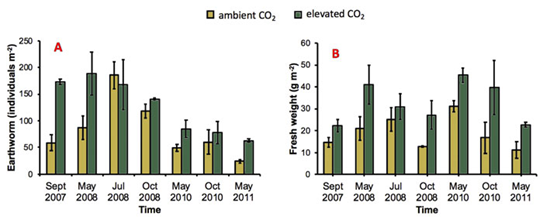From the CO2Science archive: Noting that very few studies have examined the impact of elevated CO2 concentrations on belowground macrobiota, Sánchez-de León et al. (2018) set out to investigate “the response of earthworms to increased leaf and root-litter inputs caused by increased atmospheric CO2 exposure.” The work was conducted at the Oak Ridge National Environmental Research Park in Roane County, Tennessee, USA, in a sweetgum (Liquidambar styraciflua) plantation. Free-air CO2 Enrichment (FACE) plots were established in the plantation in 1998, where for the following twelve growing seasons the CO2 concentration was enriched to an average 547 ppm during daylight hours. Ambient CO2 plots, in contrast, averaged 395 ppm.
Paper reviewed: Sánchez-de León, Y., Wise, D.H., Lugo-Pérez, J., Norby, R.J., James, S.W. and Gonzalez-Meler, M.A. 2018. Endogeic earthwork densities increase in response to higher fine-root production in a forest exposed to elevated CO2. Soil Biology and Biochemistry 122: 31-38.
Results of the analysis showed that both the number of earthworms and overall earthworm biomass was higher in the elevated CO2 treatment than in the ambient CO2 treatment (see Figure 1). It was also determined that the increase in the number of earthworms was “associated with higher net primary productivity” of the sweetgum trees, which responded positively to atmospheric CO2 enrichment. In short, elevated CO2 set in motion a process where it increased the growth of the sweetgum trees, particularly fine-root and leaf litter production, which stimulated belowground carbon and helped enhance the growth and activity of earthworms, which growth and activity further helped to promote and stabilize soil carbon via the formation of soil aggregates. Consequently, Sánchez-de León et al. say their results “suggest that earthworms can have a significant influence in promoting the carbon accrual observed at the ORNL FACE site through promoting physical protection in soil aggregates.”
Thus we see yet another example how CO2 emissions produced by the burning of fossil fuels are enhancing the natural world, in this case both plants and animals in a synergistic manner. And that is great news for the future.

Figure 1. Mean (± SE) earthworm numerical density (Panel A) and biomass (fresh weight; Panel B) in elevated and ambient CO2 treatments across time. Source: Sánchez-de León et al. (2018).



Why was this caused? Maybe the increased plant vigor was the direct result thus making the increased population a secondary?